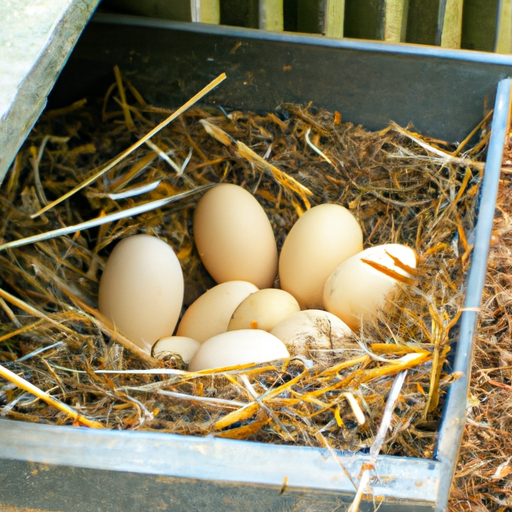Imagine having your own little flock of chickens in your backyard, providing you with fresh eggs every morning. But how many chickens should you have? Is there an ideal number that strikes the perfect balance between a bountiful egg supply and manageable maintenance? This article explores the question of the ideal number of chickens for a backyard flock, taking into consideration factors such as space, time commitment, and personal preferences. Whether you’re a beginner or an experienced chicken enthusiast, this guide will help you determine the perfect number of feathered friends to make your backyard a bawk-tastic haven.
Factors to Consider
Available Space
When determining the ideal number of chickens for your backyard flock, the available space should be one of the first factors to consider. Chickens require enough space to roam, scratch around for insects, and dustbathe. The recommended minimum space per chicken is 4 square feet in the coop and 10 square feet in the run. However, if you have the space, providing more room for your chickens is always beneficial.
Local Regulations
Before starting a backyard flock, it is essential to familiarize yourself with the local regulations regarding keeping chickens in your area. Some cities or neighborhoods may have specific rules about the number of chickens allowed, coop requirements, and noise restrictions. By understanding and adhering to these regulations, you can avoid any potential legal issues and ensure a harmonious relationship with your neighbors.
Purpose
The purpose of keeping chickens in your backyard can greatly influence the ideal number of chickens for your flock. If your primary goal is to have a fresh supply of eggs for your household, a smaller flock may be sufficient. On the other hand, if you are looking to raise chickens for meat production, a larger flock may be more appropriate. Additionally, some people keep chickens for their companionship or for participating in poultry shows, which may require a specific flock size.
Breed Selection
Different chicken breeds have varying space requirements, temperaments, and productivity levels. Some breeds are prolific layers, while others are primarily raised for meat. When choosing the ideal number of chickens for your flock, consider the breed characteristics and how they align with your goals. Selecting a breed that fits well with your available space, climate, and lifestyle can contribute to a successful and enjoyable chicken-keeping experience.
Budget
Keeping chickens involves certain expenses, including acquiring the birds, building or purchasing a coop, providing feed and bedding, and maintaining their health. The ideal number of chickens for your flock should align with your budget. The more chickens you have, the higher the initial and ongoing costs will be. By considering your financial resources, you can ensure that you can adequately provide for the needs of your flock without breaking the bank.
Chicken Math
Average Consumption
Calculating the average consumption of eggs is an essential aspect of determining the ideal number of chickens for your backyard flock. Depending on your household’s egg consumption, you can estimate how many chickens you need to meet your needs adequately. On average, a laying hen produces around 4-6 eggs per week, but this can vary depending on the breed and individual bird.
Egg Production
While considering the ideal number of chickens, it is crucial to understand their egg production patterns. Some breeds are known for their exceptional egg-laying abilities, while others have lower egg production. By researching the egg production rates of different breeds, you can estimate how many hens you need to meet your desired egg output.
Flock Dynamics
Flock dynamics play a significant role in determining the ideal number of chickens. Chickens are social animals and thrive when they have company. Maintaining a flock with a diverse range of personalities and social hierarchies can help establish a harmonious environment. However, overcrowding can lead to stress, aggression, and health issues. Therefore, finding the right balance within the flock is essential.
Breeding
If you are interested in breeding chickens, the ideal number of chickens may need to be adjusted to accommodate the breeding process. Breeding requires separate enclosures, specific ratios of roosters to hens, and considerations for mating and incubation. Planning ahead and determining how many chicks you want to hatch can help you determine the appropriate number of breeding individuals in your flock.
Predator Control
Predator control is another factor to consider when calculating the ideal number of chickens. Larger flocks tend to be more secure against predators, as there are more eyes and ears to detect threats. Smaller flocks, on the other hand, may be more vulnerable. Taking precautions to secure your coop and run, such as adding fencing and predator-proofing measures, can help safeguard your chickens regardless of flock size.
Common Flock Sizes
1-3 Chickens
For those with limited space or just starting out with backyard chicken keeping, a small flock of 1-3 chickens is a popular option. This size allows for easier management, lower noise levels, and less maintenance. It is important to note that in smaller flocks, individual chickens may form closer bonds with their human caregivers as they receive more attention and interaction.
4-6 Chickens
A flock size of 4-6 chickens is a common choice for many backyard chicken enthusiasts. With this number, you can have a diverse mix of egg-laying breeds or include chickens for meat production. This size provides a moderate number of eggs for a medium-sized household and allows for a varied social dynamic within the flock.
7-10 Chickens
A flock of 7-10 chickens is suitable for those who have larger backyard spaces and a higher demand for eggs. This size allows for more flexibility in breed selection, as you can accommodate a combination of prolific layers, meat chickens, or ornamental breeds. In larger flocks, a pecking order becomes more evident, and flock dynamics play a more significant role.
11-15 Chickens
For chicken enthusiasts with larger yards or rural settings, a flock of 11-15 chickens may be an ideal choice. This size allows for a more substantial egg production, providing a surplus for a larger household or the ability to sell eggs. Additionally, with more chickens, you can experiment with different breeds and enjoy a dynamic and diverse flock.
16+ Chickens
Flocks with 16 or more chickens are typically found in larger-scale poultry operations or rural settings with ample space. While such flocks may require more time and resources to manage, they offer the potential for more extensive egg production, greater breed diversity, and potentially some self-sufficiency in terms of eggs and meat. However, it is important to consider the increased workload and potential challenges associated with managing a larger flock.
Pros and Cons of Small Flocks
Pros of Small Flocks
Small flocks offer several advantages, especially for beginners or those with limited space. They require less space, feed, and bedding, making them more cost-effective and easier to manage. Small flocks are also quieter and produce fewer odors, reducing potential conflicts with neighbors. Furthermore, individual chickens in small flocks tend to be more accustomed to human interaction, making them easier to handle and bond with.
Cons of Small Flocks
While small flocks have their benefits, they also have some drawbacks. A limited number of chickens means a lower egg production, which may not be sufficient for larger households or those with high egg consumption. Additionally, if one chicken falls ill or dies, the impact on the flock is more significant in a small flock, potentially disrupting the social dynamic and leaving remaining chickens vulnerable to loneliness.
Pros and Cons of Large Flocks
Pros of Large Flocks
Large flocks offer their own set of advantages. With more chickens, you can achieve a higher egg production, ensuring a steady supply for larger households or even for selling. The social dynamics are more intricate and fascinating to observe in a large flock, with a more developed pecking order and interactions. Additionally, larger flocks provide a greater sense of self-sufficiency and may allow for breeding and hatching chicks on-site.
Cons of Large Flocks
Managing a large flock requires more time, effort, and resources. Daily tasks such as feeding, cleaning, and maintaining the coop become more demanding as the number of chickens increases. Large flocks may also be noisier, potentially increasing conflicts with neighbors, especially in urban settings. Moreover, larger flocks are more susceptible to disease outbreaks, and if one chicken falls ill, it can rapidly spread to others.
Finding a Balance
Tailoring to Your Needs
Determining the ideal number of chickens for your backyard flock ultimately boils down to tailoring the size to your specific needs. Consider your available space, budget, purpose, and desired level of involvement. Evaluate if you prioritize a higher egg production or if you prefer a smaller, more manageable flock that allows for closer interaction with individual chickens. By aligning your flock size with your goals and resources, you can find the perfect balance for your chicken-keeping experience.
Considerations for Urban Settings
If you live in an urban area, additional considerations come into play when determining the ideal flock size. Check local regulations and zoning codes to ensure you comply with any restrictions on flock size. Harboring a smaller flock might be more practical in an urban setting, as space tends to be limited, and noise concerns are often more prevalent. Adapting to these considerations will help you maintain a positive relationship with your neighbors and enjoy your backyard flock.
Balancing Time and Effort
The size of your flock directly affects the time and effort required for their care and maintenance. Consider how much time you can realistically dedicate to tending to your chickens. Smaller flocks generally require less time, making them more suitable for those with busy schedules or limited availability. In contrast, larger flocks demand more attention, regular monitoring, and potential expansion of facilities and resources.
Experimenting with Flock Size
Finding the right flock size may require some trial and error. If you are new to backyard chicken keeping, starting with a smaller flock allows you to gain experience and understand the demands of chicken care. As you become more comfortable, you can gradually increase your flock size if desired. Through observation and hands-on experience, you can assess the impact of flock size on various factors, such as social dynamics, egg production, and overall satisfaction with your flock.
Community Guidelines and Resources
Local Regulations and Zoning
Before starting a backyard flock, thoroughly research and familiarize yourself with the local regulations and zoning requirements. These rules often specify the maximum number of chickens allowed, coop design standards, setbacks from neighboring properties, and noise restrictions. Adhering to these guidelines is essential for maintaining a harmonious relationship with both the community and local authorities.
Neighboring Relations
Considerate and open communication with your neighbors is crucial when keeping backyard chickens. While some neighbors may embrace the presence of chickens, others may have concerns about noise, odors, or potential cleanliness issues. By addressing their concerns, providing reassurance, and considering their perspectives, you can foster positive relationships and avoid unnecessary conflicts. Sharing fresh eggs can also be a great way to promote good neighborly relations.
Backyard Chicken Associations
Joining or connecting with local backyard chicken associations can provide valuable resources and support. These associations often organize educational events, workshops, and social gatherings for chicken enthusiasts. They can offer advice on flock size, breed recommendations, coop designs, and local regulations. Additionally, being part of a chicken-keeping community allows for networking and sharing experiences with like-minded individuals.
Online Resources
The internet is a vast resource for backyard chicken keepers. Numerous websites, forums, and social media communities cater to the needs of chicken enthusiasts. Online resources can provide valuable information on all aspects of chicken care, including flock size considerations. Engaging in online discussions and seeking advice from experienced members can enhance your knowledge and confidence in managing your flock.
Conclusion
Determining the ideal number of chickens for your backyard flock is a personal decision that depends on various factors. Considerations such as available space, local regulations, purpose, budget, and breed selection all play a role in determining the appropriate flock size. Evaluating the pros and cons of both small and large flocks can help you find the right balance between your goals, resources, and level of involvement. By following community guidelines, engaging in local associations, and utilizing online resources, you can gather the information and support necessary for a successful and enjoyable chicken-keeping experience. Whether you choose a small flock for intimacy or a larger flock for self-sufficiency, embracing the joys of having chickens in your backyard will undoubtedly enrich your life.




